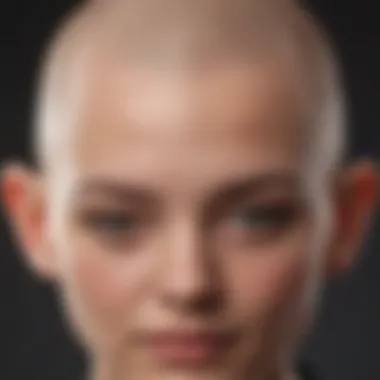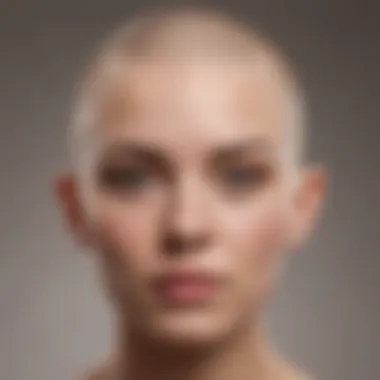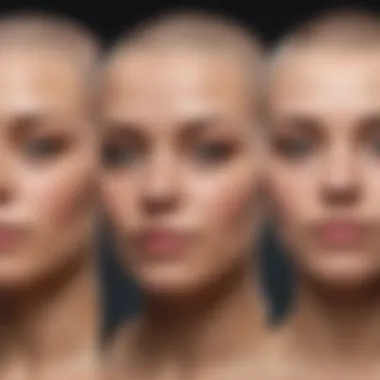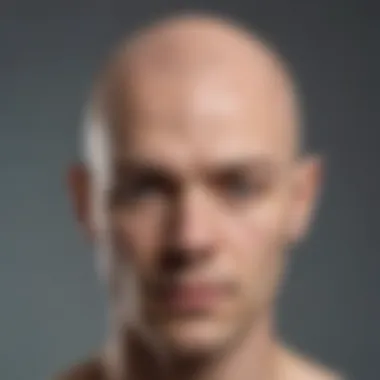Exploring the Aesthetic and Psychological Effects of Shaved Heads


Intro
The decision to shave one's head evokes various responses and interpretations. A shaved head communicates strength, rebellion, or personal transformation. Many perceives baldness as a statement about identity and individuality. The thorough exploration of aesthetics, emotional responses, and societal perceptions becomes essential for those considering this change.
Wellness
Physical Health
Shaving one's head can signify more than mere aesthetics. For some, it serves practical health benefits. Grooming routines simplify; no more worries about maintaining style, cutting, or styling specific hair types. When individuals experience hair loss due to health conditions like alopecia, a shaved head can foster acceptance and reshape their consciousness surrounding self-image.
Mental Health
Psychological effects of shaving one’s head are profound. For many, it provides a sense of freedom from societal beauty standards. However, dissociating from societal norms can lead to identity reformation, prompting deeper consideration regarding self-esteem and confidence. People report greater reinvigoration akin to a personal reset that suppresses the anxiety tied to hair loss or transformed self-image.
Nutrition and Diet
While nutrition may seem distanced from hairstyle choices, a balanced diet influences hair health. Nutrient-rich diets could nurture the remaining hair and, in some cases, making the intimate connection between personal health and aesthetic choices clearer. Foods rich in vitamins, like B-complex vitamins and minerals, affect the well-being of skin and hair, making this a potential reflection of style change successfully integrating lifestyle shifts.
Fitness and Exercise
Physical vitality complements mental resilience. Regular exercise cultivates positive reflections on one's body image, increasing self-acceptance. For many, adopting a shaved head complements a fitness mindset. The visual simplicity often seen in animalistic depictions in sports creates connections and understanding across athletic community in a figurative sense.
Aesthetic Factors
Shaving one's head alters how individuals perceive themselves and how others view them. This aesthetic impact is multifaceted, affected by various factors, including face shape and individual characteristics like facial hair types and blemishes.
Face Shapes and Visual Impact
The interplay of baldness and facial architecture attracts significant interest. Individuals with oval faces often exude harmony and balance with shaved impressions, creating an unsettling symmetry, while square-faced individuals may express more rugged masculinity.
The Visual Impact of a Shaved Head
The act of shaving one’s head engenders a profound visual metamorphosis. The shaved head functions not only as a style but also as an expression of identity. Factors like face shape, hair type, and skin tone are pivotal in determining how baldness will be perceived on an individual, hence these elements merit detailed exploration. These considerations can significantly affect how one feels about themselves, as well as how others engage with them. Below, the impact of distinctive traits serves as a framework for understanding the aesthetic nuances of a shaved head.
Understanding Face Shapes
An individual’s face shape is essential in gauging how a shaved head complements their visuals. Common face shapes include oval, round, square, and heart.
- Oval Shapes – Those with oval faces generally possess a versatile look that allows them to experiment with various hairstyles, including a shaved head. The balance of facial proportions tends to exhibit a symmetrical outline, enhancing their appearance with minimal hair.
- Round Shapes – Individuals with round faces often find a shaved head provides an elongated appearance, which can be empowering. The starkness of a bald head contrasts with softer facial features, emphasizing structure.
- Square Shapes – A shaved head can exhibit strength when paired with a square face shape, showcasing sharp jawlines and prominent features effectively. It projects an assertive visual impact communicating confidence.
- Heart Shapes – The angular characteristics of a heart-shaped face emerge robustly when hair is omitted. The greater visibility of the forehead adds uniqueness to the overall discussion surrounding aesthetics.
Navigating this facet of baldness entails realizing each face shape possesses its advantages when embraced with confidence.
Hair Type Considerations
Deciding to shave one’s head is not solely a style choice; it can interplay tightly with an individual’s hair type, which might evoke various emotions or approaches. Hair that is thick or curly could pose challenges during the shaving process, leading to uneven results if not maintained carefully. On the opposite spectrum, thinning or straight hair may render closeness to the scalp more manageable and visually appealing.
- Curly Hair – The texture could result in an unusual appearance, especially if the curls grow back, but some view the contrast as liberating, embracing newfound freedom.
- Straight Hair – A straight hair type often presents smoother aesthetics. The consistency can provide a distinct and sharp look suited for various settings or professional environments.
- Fine Hair – A shaved head can bring relief and ease to care associated with fine hair whilst contributing a sophisticated vibe.


Understanding personal hair characteristics establishes framework for proceeding with a smooth transition and avoids disappointing results.
Complexion and Skin Tone
Complexion and skin tone also carry weight in how those around perceive a shaved head. Variegated skin tones offer substantial depth in terms of overall appearance.
- Light Skin Tones – Individuals with fair skin may need to consider sun exposure, as a shaved head could lead to various sunburn concerns.
- Medium Skin Tones – A shaved head often highlights natural shades, potentially casting warm and rich tones that align with personal attributes.
- Dark Skin Tones – Particularly stunning visuals manifest when individuals with darker skin tones adopt a shaved head. The stark contrast typically appeals, producing complements of deep color and vibrancy.
Effective consideration of one's complexion leads to an enriched understanding of how would feel and be viewed in public. Exploring these realms guides toward a thorough assessment in the individual's shaving journey.
Psychological Effects of Shaving Your Head
The psychological effects of shaving your head extend beyond just appearance. This decision can represent a significant transformation in a person's identity, reflecting various internal and external changes. For many, shaving the head might serve as an act of empowerment or a symbolic cleansing of past experiences.
Personal Transformation
Shaving your head can be a powerful catalyst for personal transformation. Individuals often engage in this act after life-altering experiences, such as a loss or major change. This signifies a fresh start, often purposefully shedding old associations with hair. Many find a sense of liberation in removing this personal attribute, which can lead them to explore other avenues of self-discovery. By stripping away hair, a person may confront deeper issues that have long been covered up by societal expectations surrounding beauty. Confirming one's essential self beyond conventional beauty standards can help in developing resilience and a new sense of self-worth.
Confidence and Self-Image
There is a notable relationship between how one perceives oneself and the act of shaving the head. Many individuals report an increased level of confidence after doing so. Once the initial shock of the new appearance subsides, they often embrace the boldness that comes with it. With hair often seen as a mainstay of attractiveness, losing it can force one to redefine beauty from within. This engagement might improve self-image immensely; participants frequently refer to significant improvements in mood and assertiveness following this decision.
Furthermore, research suggests that adopting a shaved head alters others' perceptions. Many perceive bald individuals as more assertive and dominant. This societal acknowledgment can reflect positively back onto the individual, potentially reinforcing their sense of confidence.
Coping with Change
Adjusting to the psychological implications of losing one's hair can vary among individuals. Shaving heads can serve as fact to cope with stress linked to change. Whether this is a voluntary decision or against one’s will due to health issues, understanding how to navigate these emotional shifts is vital. Embracing change helps individuals realize their adaptability.
This coping mechanism can manifest in several ways:
- A form of expression
- A tool for managing unexpected challenges
- An opportunity to connect with others who have undergone similar experiences
Processing the change involves understanding the loss of autonomy over one’s image. By confronting these feelings directly, individuals may find themselves equipped with enhanced emotional skills. Psychological growth follows, often empowering them in all aspects of life. Surviving this transformation can signify that one combats adversity effectively, which could prepare them for future challenges in life.
Shaving your head can illuminate paths of self-discovery and inner strength, reminding you that change can be embracing and transformative.
Societal Perceptions of Baldness
Understanding societal perceptions of baldness is crucial. This aspect encompasses the views and judgments that people develop toward individuals with shaved heads. It deals not only with aesthetic implications but also impacts psychological well-being and identity.
Cultural Representations
Cultural representations of baldness vary significantly across different societies. In some cultures, a shaved head can symbolize wisdom and maturity. This is often observed in older men or figures of authority. In contrast, certain entertainment mediums associate baldness with villainy or states of distress. Media portrayal greatly influences how people interpret someone shaving their head. This can create pressure or approval depending on the narrative surrounding baldness in that culture.
Relevant cultural narratives can be one of escalation, respect, or even ridicule. For example, some juvenile comic book characters vitalize baldness as comedic genius, doing little favours to the public perception. In contemporary fashion, celebrities often adopt the shaved head to portray strength and defiance. This creates variability in acceptance levels among different age groups and cultures.
Gender Differences in Perception


Gender differences can significantly influence how baldness is perceived. Men usually are more accepting of going bald, often signaling self-assurance or an 'alpha' stance. For them, baldness tends to be associated with masculinity. Many male public figures sport a shaved head, enhancing its acceptance and appeal.
On the other hand, women facing hair loss or a shaved head may benchmark a range gap to hear societal expectations. Societal Notes often paint long hair as a femininity symbol. Women who shave their heads encounter mixed reactions that can lead to scrutiny or admiration. Thus, the double standard creates a environment laden with bias and contrasts in experience dependent solely on the observer's gender perspective.
Stereotypes and Assumptions
Stereotypes related to baldness can be damaging. People often make quick judgments based on appearance, attaching notions such as aggressiveness or inferiority. Unfortunately, some believe that bald women are unsightly or confrontational. Stereotypes reduce complex identities to simplistic ideas. Upon noticing a shaved head, assumptions can swiftly follow, overshadowing the person as an individual.
It's important to examine prevailing stereotypes. They manifest in various forms, whether in social situations or professional areas. Associating baldness with negative traits stems largely from ignorance and sociocultural conditioning. These preconceived notions show how ingrained societal beliefs influence everyday life, affecting opportunities, connections, and personal achievements.
Making assumptions based solely on a shaved head neglects the nuanced identity beyond appearance.
Recognizing societal perceptions allows individuals to navigate these predispositions effectively. By fostering awareness and promoting positive narratives, it is possible to reshape how baldness is viewed entirely. This equilibrium creates an environment where self-expression can occur without fear of judgment.
Practical Considerations for Shaving Your Head
Understanding the practical aspects of shaving one’s head is vital for making an informed choice. This section addresses essential tools, aftercare, and mental preparation required for the act. It provides insight into creating a smooth transition while highlighting potential benefits and considerations.
Tools Needed for Shaving
Identifying the right tools can significantly influence the experience and result of shaving your head. Proper equipment not only improves effectiveness but also enhances safety and comfort in the process. Consider the following tools:
- Razor: A high-quality, sharp razor is crucial. Options like the Gillette Fusion5 or the HeadBlade are popular for their precision and ease of use.
- Clippers: Before shaving, trimming longer hair with clippers is advised. Models from Wahl or Andis can work well.
- Shaving cream or gel: A suitable non-foaming shaving cream reduces irritation. Look for those specifically designed for sensitive skin.
- Aftershave lotion: To soothe the skin post-shave, use an alcohol-free aftershave or moisturizer, which hydrates and calms.
- Mirror: Ensure access to a well-lit mirror, allowing for precision and clarity during the process.
Using the appropriate tools allows for a cleaner shave, which can minimize irritation and lead to a better overall look.
Aftercare and Maintenance
Aftercare is often overlooked but plays a crucial role in maintaining healthy skin after shaving your head. Bald skin can be sensitive and prone to irritation.
- Hydration: Apply a suitable moisturizer immediately after shaving. This will help to replenish lost moisture and soothe any post-shave sensitivity.
- Sun Protection: Without hair, the scalp is exposed to UV rays. Every day, apply sunscreen or wear a hat when going outdoors to prevent sunburn and skin damage.
- Regular Shaving Schedule: Maintenance frequency can vary based on hair growth rate. Shaving every two to three days or as needed is commonly recommended to maintain a clean look.
- Monitoring Skin: Watch for any signs of irritation, red bumps, or ingrown hairs, especially in the week following head shaving. Address problems early to avoid serious skin issues.
Adhering to these post-shaving practices will help keep your head healthy and feeling comfortable in the longer term.
Preparing for Reactions from Others
Shaving your head can trigger varied reactions in those around you, ranging from admiration to confusion or unsolicited comments. Preparing mentally for these responses is an important element of the shaving process.
- Self-Assessment: Begin by reaffirming the personal reasons for this change. A strong self-image going into such a decision helps mitigate negative feedback.
- Common Reactions: Understand that some may respond positively while others might not understand your reasons, potentially prompting questions or jokes. Expecting this variation can lessen shock value.
- Support System: Communicate with friends or family prior to making the change. Their support can offer comfort and assurance during the transition.
- Staying Confident: Remember, your bald head reflects a personal choice. Confidence in the decision will communicate strength in your new look.
Think about potential responses and prepare accordingly. This mental groundwork will offer a clearer, steadier experience as you navigate reactions, both positive and negative.
Embracing experiences and reactions surrounding a shaved head contributes to both the process and its outcomes shaped by aspiration and change.
Long-Term Effects of Having a Shaved Head
Understanding the long-term effects of shaving one's head is crucial, especially for individuals considering making this significant change. While many people may think of the aesthetics and immediate outcomes, the sustained impact on identity, personal style, and social interactions can shape experiences in profound ways. It is essential to consider both the benefits and potential challenges that can arise from this bold choice.


Changing Identity and Image
For many, shaving the head marks a transition. It could represent a new phase in life, signal a break from old habits or experiences. This transformation can be empowering. People often report feelings of liberation after shaving their heads. When hair is gone, a person's features can stand out more, creating a stark, new identity.
Additionally, it may help individuals confront societal expectations regarding beauty. With expectations deeply embedded in hair being equated to femininity or masculinity, choosing to go against these trends can lead to self-discovery. Those who shave their heads frequently report a growth in resilience avant de facing scrutiny or judgments.
The act can lead to redefining self-image. Instead of being bound by societal norms, individuals can embrace a stronger, more unique sense of self, as hair often holds personal memories or connections.
Evolution of Personal Style
A shaved head often leads to new explorations in fashion and personal style. With the absence of hair to draw attention, attire tends to become more critical. This lack of hair allows the individuality of someone's clothing and accessories to shine brighter.
Some individuals may gravitate towards minimalist styles, while others embrace more audacious statements. The exploration can help reinvent how one wishes to present themselves. Openness about varied expressions and styles often increases, leading to creativity in choice of clothing.
Here are several considerations in this journey:
- Outfits: Individuals might find themselves experimenting more with sophisticated pieces.
- Accessories: The style adapts as some may choose hats or scarves strategically.
- Makeup and Grooming: Attention turns to these areas, which can provide yet another dimension to individual style.
Ultimately, this evolution can reinforce one's sense of identity over time as individuals find comfort and confidence in expressing themselves anew.
Social Dynamics and Interactions
Over time, a shaved head can lead to changes in social interactions. Initial reactions will vary, ranging from admiration to hostility. Many individuals recount that their change led to stronger bonds in some social groups while resulting in distancing from others. Some surveys even suggest that baldness is often linked to perceptions of courage and independence.
In work settings, perceptions can shift significantly. A shaved head may invoke confidence in professional circles. Colleagues might respond differently, gauging this choice as far-reaching in terms of traditional expectations regarding appearance.
Further factors include:
- Confidence Levels: Social anxiety may diminish as individuals adapt.
- Power Dynamics: The shaved head is seen in many cultures as a symbol of strength and control.
- Misconceptions: Noting stereotypes and biases is vital as common assumptions can color interactions.
In summary, the long-term effects of a shaved head create new layers of meaning and interaction in one's life, proving to be about much more than just aesthetics it enables a deeper exploration of identity, self-expression, and social dynamics.
Concluding Thoughts on Shaving Your Head
The choice to shave your head is not a trivial one. It extends beyond mere aesthetics; it involves reshaping one's very identity. This article has chronicled various facets surrounding this decision, underscoring how man seen, both personally and socially, can shift dramatically as a result of adopting a bald look.
Making an Informed Decision
Considering the importance of knowledge is paramount before taking this step. Understanding the implications is vital, especially for those who might be influenced by trends, personal stakes, or deeper motivations.
- Assessing your reasons for shaving your head can clarify your commitment to this change. Variety intentions, like personal reinvention or coping mechanisms, guide the actual adoption.
- Consulting the opinions of people who embraced this transformation can provide insights that pinpoint what to expect. If available, speak with a professional stylist who may differentiate what will suit you best.
- Evaluating face shape and skin tone previously discussed factors enable you to understand which styles may be produced. Furthermore, inclusive of your environment, the long-lasting characteristics will eventually play into the decision.
Ultimately, an informative approach lays the groundwork for potential disconnection or discovery depending on individual expectations.
Reflecting on the Experience
In reflecting on the experience of shaving one's head, substantial growth can arise.
- Documentation through personal observation plays an advantageous role in way perceived emotionally. Journaling key thoughts or experiences during the transition provides clearer clarity on feelings reorganized over time.
- Figuring out things that outwardly impress might shift internal perspectives as well. Once heading towards perfection of hygiene or stylistic shifts can gradually change comforts. Monitoring emotional trends may also reveal initiation into this new chapter.
- Community can provide profound insight. benefitting from shared stories on platforms such as Reddit regarding acceptance and the positive turn outcomes of less hair may further bolster growth and understanding.
Remaining receptive towards these experiences proves crucial, deepening this transformative path and allowing continual evolution. Reflecting not only builds oneself but significantly shapes avenues connecting to others who have embraced this choice.
In summary, the decision to shave one's head serves as more than mere change. Instead, it stands parallel with personal discoveries and adaptability bridging various types of human experience. Whether perceived as liberating or a temporary escape, comprehending its layers positions one well for the journey ahead.



